Prehistoric sites
|
Stone circles |
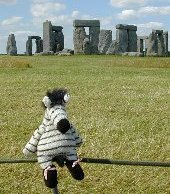 |
Perhaps one of the most famous archaeological sites in the world, Stonehenge is in Wiltshire.
Beany Z says:
Stonehenge has a long and complex history which is open to interpretation. The site consists of a stone circle built of trilithons (three stones made into a pi-shape) inside an earlier henge monument. A henge is a circular earthen bank. Most henges do not contain stone circles.
|
|
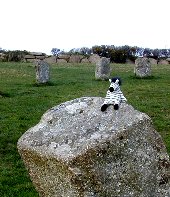 |
A simpler Bronze Age stone circle called the Merry Maidens can be seen near Lamorna, Penwith, Cornwall.
Beany Z says:
This circle is almost 24 metres across and is made up of nineteen stones. There is a possible entrance (or missing stone) to the east. Three menhirs are thought to be associated with the circle, and these are known as the Pipers and the Fiddler. Folklore suggests that the circle represents a group of girls, and the menhirs three male musicians, turned to stone for dancing on a Sunday.
|
|
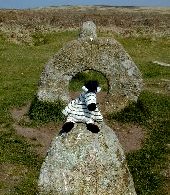 |
Men-an-Tol near Madron, Penwith, Cornwall, is a holed stone which formed part of a stone circle.
Beany Z says:
Archaeologists have discovered that this holed stone was part of a stone circle 18 metres in diameter. It may have had some other purpose originally, but this is a matter for speculation. In Cornish folklore, crawling through it was supposed to be a cure for back ache.
|
|
Burial sites |
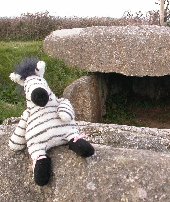 |
A well-preserved and easily accessible burial site can be found at Tregiffian, near Lamorna, in Cornwall.
Beany Z says:
Tregiffian is a Neolithic Scillonian chamber tomb, or 'entrance tomb'. It consisted of a circular mound, now cut in half by the B3315 road, over an entrance passage and chamber constructed of large stones, and a kerb of smaller stones. It is close to the later stone circle known as the 'Merry Maidens' (see above).
|
|
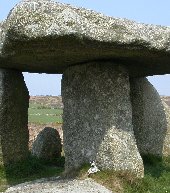 |
Lanyon Quoit near Madron, Cornwall, is one of the most well-known prehistoric monuments in the county.
Beany Z says:
Quoits are the remains of stone-built Neolithic burial chambers which were originally below earthen mounds like that at Tregiffian (see above). Lanyon is one of the largest, but it collapsed in 1815 and was later reconstructed with the capstone much lower, and with only three of the original four supporting stones.
|
|
Settlements |
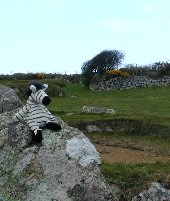 |
The Iron Age settlement of Carn Euny in Penwith, Cornwall, is one of several preserved in the area.
Beany Z says:
The village consists of the remains of four courtyard houses, several round houses and a long underground tunnel or fougou. It dates to the 1st century BC in this form, but excavations have shown that there was Bronze Age occupation on the site. A farm cottage was built on the site in the 18th century.
|
|
|









